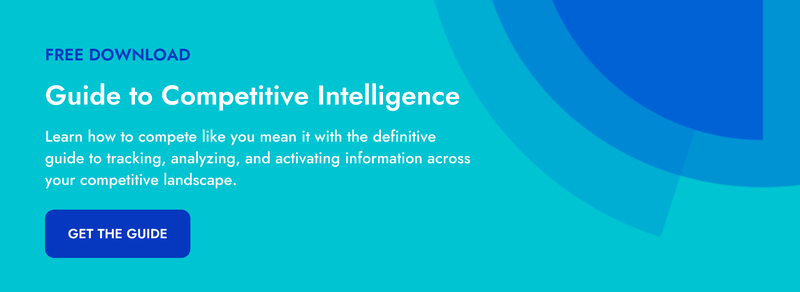The space race. SATs. Where the best barbecue hails from.
Nothing is more American than competition.
Forgive me—that’s not true. Nothing is more American than the desire to win.
And what holds true in interstellar exploration, standardized testing, and brisket is also the case when it comes to business.
Enter competitive differentiation—the leg up you’ve been looking for.
Whether it’s an expanded set of features, unbeatable price, or a brand that’s totally synonymous with category excellence, a competitive differentiator is simply a trait that makes a product more appealing to target customers than the other available options.
In this blog post, we’ll go deep on competitive differentiation, digging into three businesses leveraging dramatically different tactics to differentiate in highly competitive spaces.
GET YOUR FREE COPY OF THE GUIDE TO COMPETITIVE INTELLIGENCE ↓
What is competitive differentiation?
Maybe your product is the most user-friendly. Perhaps your price can’t be beat. Could be that you've got the most responsive CS team east of the Mississippi.
If you’re actively articulating any or all of the preceding sentiments in your messaging, congratulations: You’re practicing competitive differentiation.
Competitive differentiation describes how your product stands out against the topography of your competitive landscape. Or, framed as a question and without cartographic allusion: How is the thing you sell different from the things your competitors sell?
It’s the process of taking product features and turning them into the best solutions for your ideal customer.
Why? Because features alone don’t differentiate. Neither does exceptional messaging composed in a vacuum.
If you want to win, your focus needs to live at the intersection of
- What you do better than everyone else, and
- What solves the problems that matter most to your target customer
Let’s take the crowded world of no-code dev platforms, for example:
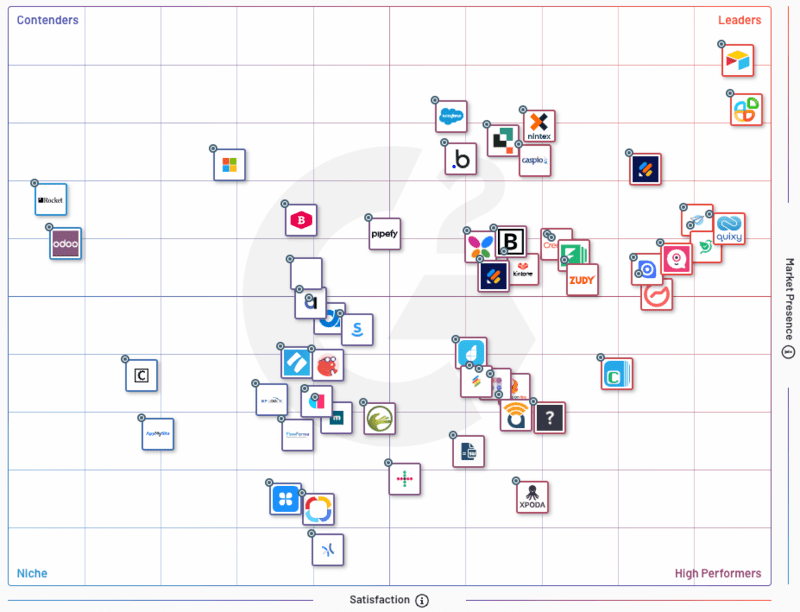
Each quadrant is riddled with successful businesses, most of which offer users—from scrappy solopreneurs to individual teams at Fortune 500’s with a mandate to “go fast” sans dedicated dev resources—the same suite of tools at a fairly comparable price.
How, then, has Airtable managed to claw its way to the top of the mountain?
(Hint: It’s in the title of this post.)
3 traits to spotlight through competitive differentiation (with examples!)
We’ve established what competitive differentiation is. Let's turn our attention to what it looks like in the wild.
(There’s no one-size-fits-all approach here. If there were, there wouldn’t be any differentiation to observe in the wild.)
You can use virtually any facet of your product or service as a point of differentiation. All else being equal, if you can win on price and your target customer is price-sensitive, then by all means—use it as your north star.
But if price isn’t important to your customers—maybe you sell to the enterprise or a cadre of high-end teeth-whitening clinics—or it's simply not a place where you compete with others in your space, try these on for size.
Gong: It's not sales enablement—it's unlocking reality
Nebulous as it may seem, there is nothing more powerful than a well-positioned brand.
It has the power to dictate how your customers see and feel about your product. It’s how most of us decide between light beers (or hard seltzers?) to swill during NFL Divisional Round Weekend, or which hyper-practical midsize SUV to buy.
When, to the untrained eye, products in a given space all look the same, brand is what pulls one ahead of the pack.
Stated differently: Brand is the ultimate competitive differentiator.
One example of a business using brand as its primary means of competitive differentiation is Gong. Like the Airtable example above, AI-powered sales software is a crowded space. There are a lot of products that do something like this:
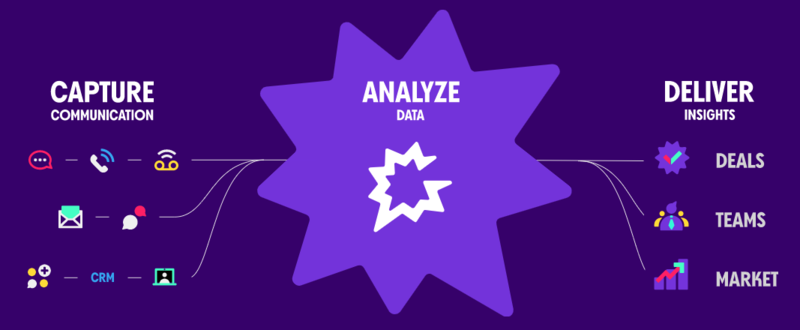
And yet Gong has become synonymous with the category of conversation intelligence.
Why? Because they aren’t just helping AEs. They're unlocking reality.
Out with the subjective, in with the objective.
By framing their brand as one that shows businesses truth and what to do with it—and then delivering on that promise, of course—Gong has positioned itself as a product that turns the voice of the customer into actionable insights in a sea of anecdote aggregators.
Toast: A product that flat-out works
A cursory Google search recently informed me that—using something resembling math—if a picture is worth a thousand words, a video is worth 1.8 million of ‘em. With that in mind, I present for your viewing pleasure, Toast:
This incredible campaign, produced by irreverent Boston-based agency Colossus, is textbook competitive differentiation through product. It takes everything great about Toast’s hardware-meets-software POS solution—the marrying of which makes them a true “all-in-one” restaurant management solution—and contextualizes it by bringing the customer to a nightmare scenario they know all-too-well: A world without Toast.
While the campaign is a touch hyperbolic, it:
- Highlights industry-wide pain points,
- Presents a silver bullet, and
- Paints the customer (restaurant owner) as a hero for simply making the right choice
When presented with such a strong set of product-centric differentiators, who could possibly settle for sentient spools of thermal paper, customers flinging wads of cash, and a chef de cuisine bathing himself in unnamed amber bisque?
Wayfair: More, more, more—no matter where you are
“The best ability is availability” — Every high school football coach in America, probably.
Offering users access to everything can go wrong in so many ways. Unnavigability. Analysis paralysis. Supply chain woes. “Jack of all trades, master of none” isn’t generally considered a compliment.
But what if a business could actually deliver on the promise of access to everything?
Enter Wayfair, the online furniture retailer that could win on price …
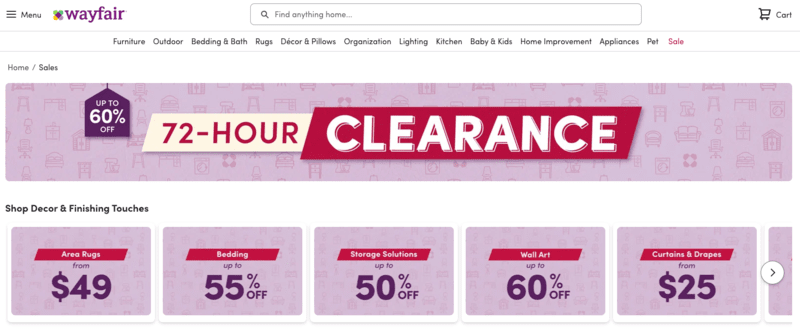
… but actually uses ubiquity as its primary tactic for competitive differentiation.
Wayfair’s “you’ve got just what I need” jingle isn’t just an earworm: It’s a testament to the brand’s primary mode of competitive differentiation. I can go to Lowes to buy subway tiles for my backsplash. I can go to Ikea and pick up a dining table. I can go to Wayfair and buy both.
In fact, 29 million people do just that:
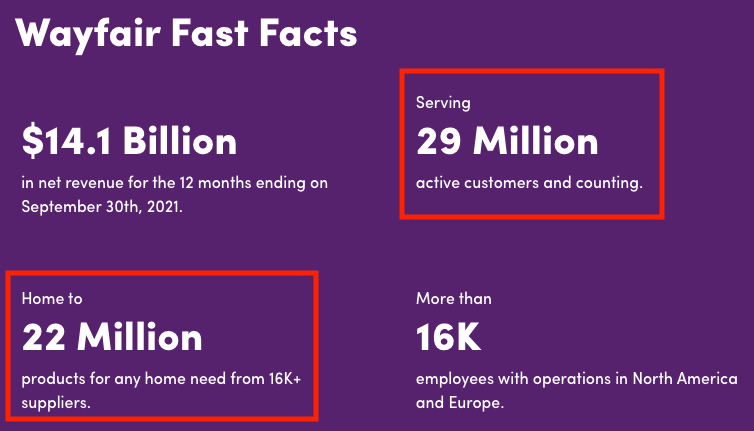
The only way to stand out in a crowded market—and ecommerce: home furnishing edition is just that—is to show customers why your solution is the best solution for them. Wayfair does just that, whether “living in rural Nebraska or downtown London,” by “being the destination for all things home and a place that helps everyone, anywhere, create their feeling of home.”
3 tactics for identifying your key competitive differentiators
Ultimately, there are three things that you need to have a firm grasp of before you can implement competitive differentiation effectively:
- Your product: What makes your solution so great?
- Your competitors: What is everyone else in your space selling? How are they attempting to differentiate?
- Your customer: What keeps them up at night?
Obviously, it takes legwork to grasp all this. Which brings us to ...
Assess your strengths
It’s time to conduct a good ‘ol fashioned SWOT analysis!
Get together with key stakeholders and answer the following five questions as honestly as possible:
- What value do you provide that can’t be replicated by anyone else in the market?
- Why do customers give you their business? What keeps them coming back?
- What are you most proud of? What are your employees and/or coworkers most proud of?
- In what ways is your product or service superior?
- What’s your gut reaction when asked for a comparison between your business and theirs?
This is a great starting point for determining your differentiator, as it forces you to look inward. Better still, it provides a lens through which to honestly assess your competitors’ strengths.
Find out what your competitors say about themselves
You know whose business you’re competing for and what you’re bringing to the table—but what about the other guy? Understanding how your competitors talk about themselves allows you to take whatever fell into the top left-hand bucket in that SWOT analysis you just did and turn it into kryptonite.
Unfortunately, without software, collecting and analyzing this intel is a full-time job.
There are a million and one data points (trust us, we’ve seen them all) you could sift through, and by the time you’ve pulled them all together, something is bound to have changed. Competitive analysis as a means of nailing down competitive differentiation is an ongoing process; when they zig, you need to zag.
Listen to your customers
When in doubt, go straight to the source.
Customers are perhaps the most powerful place to uncover product differentiation. What do they do every day? What makes them pull their hair out? What makes them feel good? What would make them feel even better? What can only you give them?
Listen closely and your customers will tell you exactly what problem they have managed to solve with the help of your product. How sales are up 127% year-over-year. How hiring has never been easier. How they made it to their kid’s 6pm swim meet for the first time since 2015.
Here’s what Gong's customers have to say:
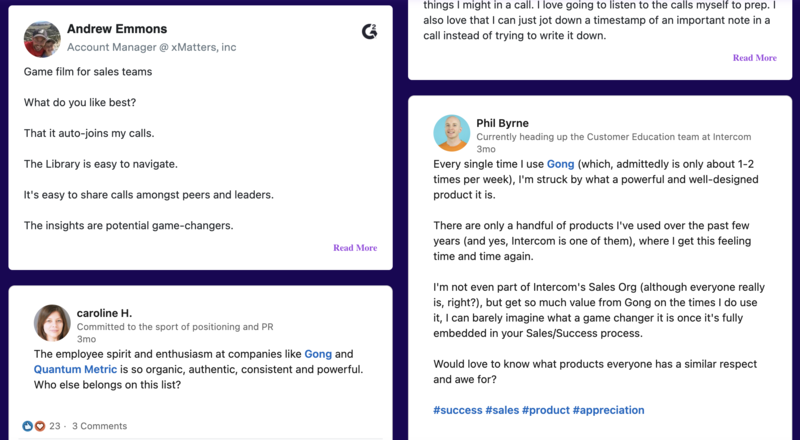
Based on this feedback, it’s pretty clear that Gong should focus on its cross-departmental application (it ain't just for sales teams); if that aligns with the results of an internal review and isn’t how competitors are extolling the virtues of their products, I’d say they might just have a point of competitive differentiation on their hands!
Putting it all together
At the end of the day, the mantra for competitive differentiation is simple:
True. Relevant. Provable.
If the trait you’re hanging your hat on is true, it matters to your customer, and you can back it up with evidence, you’ve got a winner on your hands.
Most of your competitors will spin their tires saying the same thing as everyone else (with a dash of hyperbole for effect). Be better. Find what makes your product unique in the eyes of the audience who matters most, and bake it into every touchpoint.

Seeing is believing! Check out Crayon for yourself.
Take a Product TourRelated Blog Posts
Popular Posts
-
 The 8 Free Market Research Tools and Resources You Need to Know
The 8 Free Market Research Tools and Resources You Need to Know
-
 6 Competitive Advantage Examples From the Real World
6 Competitive Advantage Examples From the Real World
-
 How to Create a Competitive Matrix (Step-by-Step Guide With Examples + Free Templates)
How to Create a Competitive Matrix (Step-by-Step Guide With Examples + Free Templates)
-
 24 Questions to Consider for Your Next SWOT Analysis
24 Questions to Consider for Your Next SWOT Analysis
-
 How to Measure Product Launch Success: 12 KPIs You Should Be Tracking
How to Measure Product Launch Success: 12 KPIs You Should Be Tracking
